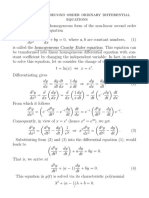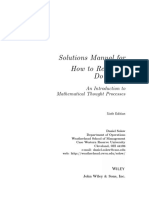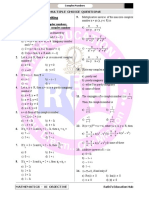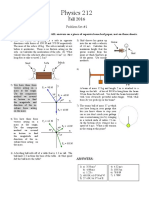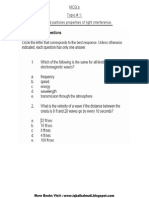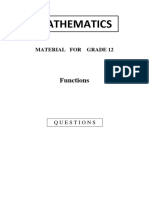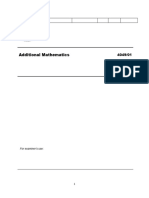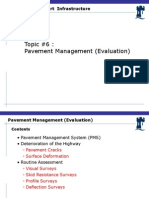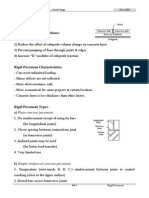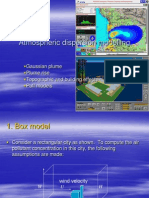1 VectorCalculus S
1 VectorCalculus S
Uploaded by
Fatmah El WardagyCopyright:
Available Formats
1 VectorCalculus S
1 VectorCalculus S
Uploaded by
Fatmah El WardagyOriginal Description:
Original Title
Copyright
Available Formats
Share this document
Did you find this document useful?
Is this content inappropriate?
Copyright:
Available Formats
1 VectorCalculus S
1 VectorCalculus S
Uploaded by
Fatmah El WardagyCopyright:
Available Formats
Vectors Calculus
Some Vector Properties (Revision)
The Scalar Product (Dot Product)
Definition The dot product a b of 2 vectors a = a1 , a 2 , a3 and b = b1 , b2 , b3 is defined as
a b = a b cos
where is the angle between a and b. In component form,
ab
Properties of the scalar product i. Parallel vectors
= a1b1 + a 2 b2 + a 3 b3
If a and b are parallel, then ab = |a||b| or -|a||b| Note: When a = b, ab = aa =|a|2 ii. Perpendicular vectors For non-zero vectors a and b,
ab = 0 a b
iii. Scalar product is commutative, that is ab = ba
The Vector Product (Cross Product)
The cross product (a b ) of 2 vectors a = a1i + a2j + a3k and b = b1i + b2j + b3k is a vector v = a b where |v| = |a||b|sin and is the angle between a and b The direction of v is perpendicular to both a and b and such that a, b, v in this order form a right-handed triple Note: a b = - b a that is vector product is not commutative.
Vector product of parallel vectors If a and b are parallel vectors, a b = 0. If a, b 0, then a b = 0 a is parallel to b
Vector product of vectors in Cartesian component form
i a b = a1 b1
j a2 b2
k a3 b3
=i
a2 b2
a3 b3
a1 b1
a3 b3
+k
a1 b1
a2 b2
= (a 2 b3 a 3 b 2 )i (a 1b 3 a 3 b1 ) j + (a1 b 2 a 2 b1 )k
Vector Functions
A vector-valued function, or vector function, is a function whose domain is a set of real numbers and whose range is a set of vectors. If f(t), g(t) and h(t) are the components of the vector r(t), then f, g and h are real-valued functions called the component functions of r and
r (t ) =
Suppose that f, g and h are continuous real-valued functions on an interval I. Then the set C of all points (x, y, z) in space, where x = f(t) y = g(t) z = h(t)
and t varies throughout the interval I, is called a space curve. The equations above are called parametric equations of C and t is called a parameter. The space curve is traced out by a moving particle whose position at time t is (f(t), g(t), h(t)). Hence, the vector r(t) is the position vector of the point P(f(t), g(t), h(t)) on C. Example Describe the curve defined by the vector function r (t ) = cos ti + sin tj + tk .
Derivatives of Vector Functions Suppose points P and Q have position vectors r(t) and r(t + h), then PQ = r (t + h ) r (t ) is known as the secant vector on the space curve C. z Q
C 0 y
x Definition: Derivative at a point The vector function r(t) = f(t)i + g(t)j + h(t)k is differentiable at t = to if f, g and h are differentiable at to. The derivative is the vector
r' (t ) =
Note: i. ii.
r(t + h) r(t ) df dg dh dr = lim = i + j+ k dt h0 t dt dt dt
A vector function r is differentiable if it is differentiable at every point of its domain. The vector r ' (t ) is called the tangent vector to the curve defined by r at the point P, provided that r ' (t ) exists and r ' (t ) 0 . Unit tangent vector: T(t ) =
iii. Examples 1.
r ' (t ) . r ' (t )
Find the derivative of r (t ) = 1 + t 3 i + te t j + sin 2tk . Also, find the unit tangent vector at the point where t = 0.
Differentiation Rules for Vector Functions Let u and v be differentiable vector functions of t, C a constant vector, c any scalar and f any differentiable scalar function. 1. 2. Constant Function Rule: Scalar Multiple Rules:
3. 4. 5. 6. 7.
Sum Rule: Difference Rule: Dot Product Rule: Cross Product Rule: Chain Rule:
d C=0 dt d [cu(t )] = cu' (t ) dt d [ f (t )u(t )] = f ' (t )u(t ) + f (t )u' (t ) dt d [u(t ) + v(t )] = u' (t ) + v' (t ) dt d [u(t ) v(t )] = u' (t ) v' (t ) dt d [u(t ) v(t )] = u' (t ) v(t ) + u(t ) v' (t ) dt d [u(t ) v(t )] = u' (t ) v(t ) + u(t ) v' (t ) dt d [u( f (t ))] = f ' (t )u' ( f (t )) dt
Example If A = 5t 2 i + tj t 3 k and B = sin ti cos tj , find d (A B ) .
dt
Scalar and vector fields A scalar or vector quantity is said to be a field if it is a function of position. A scalar field associates a scalar value to every point in space. For example, f ( x, y, z ) is a scalar function of 3 variables and defines a scalar field in space. A vector field on a domain in the plane or in space is a function that assigns a vector to each point in the domain. A field of three-dimensional vectors could be written as
F ( x, y, z ) = F1 ( x, y, z )i + F2 ( x, y, z )j + F3 ( x, y, z )k
Diagram on the left shows a 2D vector field
Diagram on the left shows a 3D vector field
Gradient, Divergence and Curl
The vector differential operator del, , is defined by
i+ j+ k = i + j +k x y z x `y z
This vector operator possesses properties analogous to those of ordinary vectors. The operator is also known as nabla. The Gradient Let f(x, y, z) defines a differentiable scalar field. Then the gradient of f, written f or grad f, is defined by
f f f f = x i + y j + z k f = x i + y j + z k
Note that f defines a vector field. Examples 1. If ( x, y, z ) = 3 x 2 y y 3 z 2 , find (or grad ) at the point (1, -2, -1).
2.
Find if i. ii. = ln |r|
1 r
The component of f in the direction of a unit vector u is given by f u and is called the directional derivative of f in the direction of u. Physically, this is the rate of change of f at the point (x, y, z) in the direction u. Properties of the directional derivatives
Du f = f u = f u cos = f cos
i. Du f is maximum when u is parallel to f ; f increases most rapidly at any point in
its domain in the direction of f; the maximum rate of change of f is f .
ii. f decreases most rapidly in the direction of - f. iii. Du f = f ( u ) = f u = Du f iv. The relationships of the partial derivatives of f to the directional derivative are Di f = f i = f x , D j f = f j = f y , Dk f = f k = f z f x - derivative of f in the i direction
f y - derivative of f in the j direction
f z - derivative if f in the k direction
D i f = f x , D j f = f y , D k f = f z
v. Any direction u perpendicular to the gradient is a direction of zero change in f D u f = f cos = f 0 = 0 2
Example Find the maximum rate of change of the scalar field = + 2 at the point (2, 1, 1).
Geometric relationship between the level curves and the gradient of a function f of two variables If f is differentiable at ( x0 , y 0 ) , then f ( x0 , y 0 ) is normal to the level curve of f through
(x 0 , y 0 )
and forms the normal vector to the level curve of f at the point
(x 0 , y 0 ) .
Geometric relationship between the level surfaces and the gradient of a function f of three variables If f is differentiable at (x 0 , y 0 , z 0 ) , then f ( x0 , y 0 , z 0 ) is normal to the level surface
, is given by of f through (x 0 , y 0 , z 0 ) ; the unit normal vector to the level surface, n
= n f . f
Example Find a unit vector that is normal to the level surface x 2 y 2 yz = 11 at the point (1, 1, -5).
The Divergence Let F(x, y, z) = F1i + F2j + F3k defines a differentiable vector field. Then the divergence of F, written F or div F, is defined by
F1 F2 F3 F = x i + y j + z k (F1i + F2 j + F3k ) = x + y + z
Note: i. ii. F is a scalar field FF
The term divergence originated in the study of fluid flow; it relates to the way in which fluid flows toward or away from a point. In other words, div F ( x, y, z ) measures the tendency of the fluid to diverge from the point ( x, y, z ) . div F (x 0 , y 0 , z 0 ) > 0 net flow of fluid outwards near (x 0 , y 0 , z 0 ) .
div F (x 0 , y 0 , z 0 ) < 0 net flow of fluid inward near (x 0 , y 0 , z 0 ) . div F ( x, y, z ) = 0, F is incompressible or solenoidal.
Examples 1. 2. If A = x 2 zi 2 y 3 z 2 j + xy 2 zk , find A (or div A) at the point (1, -1, 1). Given = 2 x 3 y 2 z 4 i. ii. Find (or div grad ) Show that = 2 , where 2 = Laplacian operator. The Curl If F(x, y, z) = F1i + F2j + F3k is a differentiable vector field then the curl or rotation of F, written F, curl F or rot F, is defined by F=
2 2 2 denotes the + + x 2 y 2 z 2
i+ j+ k (F1i + F2 j + F3k ) y z x j y F2 k z F3
i = x F1
= Note: i.
F3 F2 F1 F3 F2 F1 i + k j + z x y y z x
in the expansion of the determinant the operator
, x
, y
must z
ii. iii. iv.
precede F1, F2, F3. F is a vector field. F measures circulation density at a point. If F = 0 at any point (x 0 , y 0 , z 0 ) , then F is said to be irrotational at
(x 0 , y 0 , z 0 ) .
Example If A = x 2 zi 2 y 3 z 2 j + xy 2 zk , find i. ii. A (or curl A) at the point (1, -1, 1) curl curl A
Formulae involving If A and B are differentiable vector functions and and are differentiable scalar functions of position (x, y, z), then 1. 2. 3. 4. 5. 6. 7. 8. 9. 10. 11. 12.
) = k f ( f g ) = f g ( fg ) = f g + g f
( + ) = + (A + B) = A + B (A + B) = A + B (A) = () A + ( A) (A) = () A + ( A) (A B) = B ( A) A ( B) (A B) = (B )A B( A) (A )B + A( B) (A B) = (B )A + (A )B + B ( A) + A ( B) () 2
(kf
2 2 2 + + x 2 y 2 z 2 2 2 2 is called the Laplacian operator + + x 2 y 2 z 2
where 2 = 13. 14. 15.
() = 0. The curl of the gradient of is zero ( A) = 0. The divergence of the curl of A is zero. ( A) = ( A) 2A
Conservative vector field
F( x, y , z ) = F1 ( x. y.z )i + F2 ( x, y , z )j + F3 ( x, y, z )k is conservative if it is the gradient of
some scalar function. In other words, if f ( x, y, z ) exists such that F = f , then
F( x, y , z ) = F1 ( x. y.z )i + F2 ( x, y , z )j + F3 ( x, y, z )k
is a conservative vector field and
f ( x, y, z ) is a potential function for F.
F( x, y , z ) = F1 ( x. y.z )i + F2 ( x, y , z )j + F3 ( x, y, z )k is conservative F = 0.
If F is a differentiable vector field on R3 and F = 0, then F is a conservative vector field. A conservative vector field is irrotational.
Example Show that F (x, y, z ) = 4 yi + (4 x + 2 yz ) j + y 2 k is conservative and find its potential function.
References 1. 2. 3. 4. 5. Stewart, J. (2003). Calculus. Thomson. Weir, M.D., Hass, J. and Giordana, F.R. (2005). Thomas Calculus. Pearson Addison Wesley. Salas, S.L., Hille, E. and Etgen, G.J. (2003). Calculus: One and Several Variables. Wiley. Anton, H. (1995). Calculus with Analytic Geometry. Wiley Kreyszig, E. (1999). Advanced Engineering Mathematics. Wiley
You might also like
- Xi - Maths - Chapter 11 - Hyperbolic Functions (156-165)Document10 pagesXi - Maths - Chapter 11 - Hyperbolic Functions (156-165)Dinesh BabuNo ratings yet
- CH 8 SolDocument47 pagesCH 8 SolBSNo ratings yet
- Cauchy - Euler's Second Order Homogeneous Differential Equations @@@@@@Document5 pagesCauchy - Euler's Second Order Homogeneous Differential Equations @@@@@@Marwan ElsayedNo ratings yet
- Solutions Manual For How To Read and Do Proofs: An Introduction To Mathematical Thought ProcessesDocument15 pagesSolutions Manual For How To Read and Do Proofs: An Introduction To Mathematical Thought ProcessesmiguelNo ratings yet
- MatricesDocument8 pagesMatricesMoses SikaongaNo ratings yet
- MatrixDocument15 pagesMatrixLAWAND MUSLEMNo ratings yet
- Chapter 2. Techniques of IntegrationDocument36 pagesChapter 2. Techniques of IntegrationNyx ChaosNo ratings yet
- P1 Chp12 DifferentiationDocument56 pagesP1 Chp12 DifferentiationLOLNo ratings yet
- Arjudin - Differential EquationsDocument84 pagesArjudin - Differential EquationsMuzani SongelNo ratings yet
- Navodaya Vidyalaya Samiti Regional Office Chandigarh Class: XII Session: 2020-21 Subject: Mathematics Pre Board IDocument7 pagesNavodaya Vidyalaya Samiti Regional Office Chandigarh Class: XII Session: 2020-21 Subject: Mathematics Pre Board IPoonamNo ratings yet
- W4 Applications of First Order Differential Equations - ModuleDocument6 pagesW4 Applications of First Order Differential Equations - ModuleRaison MichNo ratings yet
- Pure Math Cape Unit 1 Parametric DifferentiationDocument8 pagesPure Math Cape Unit 1 Parametric DifferentiationHugh IngramNo ratings yet
- 3c DIFFERENTIAL EQUATIONSDocument17 pages3c DIFFERENTIAL EQUATIONSSaffire0% (1)
- Complex Number Problems - 24265111Document9 pagesComplex Number Problems - 24265111Vrushali ThokalNo ratings yet
- CAPE Pure Math P1 2008-2020Document117 pagesCAPE Pure Math P1 2008-2020Leah CassieNo ratings yet
- Application+of+Derivative+ Tangent+&+Normal,+Monotonicity,+Maxima-minima - (Practice+Question) PDFDocument31 pagesApplication+of+Derivative+ Tangent+&+Normal,+Monotonicity,+Maxima-minima - (Practice+Question) PDFAditya SanjayBoob100% (1)
- Complex Number Sheet SolutionsDocument143 pagesComplex Number Sheet Solutionsayush.aher06No ratings yet
- Chapter 4 Partial Derivatives - MATH1006 CalculusDocument11 pagesChapter 4 Partial Derivatives - MATH1006 CalculusHerkhinwale OmoakinNo ratings yet
- SetsDocument52 pagesSetssuryaNo ratings yet
- Nervous System LectureDocument60 pagesNervous System LectureazwelljohnsonNo ratings yet
- 8 - Applications of Derivatives PDFDocument15 pages8 - Applications of Derivatives PDFthinkiitNo ratings yet
- Chapter 6 (Integration Techniques) : DX X XDocument27 pagesChapter 6 (Integration Techniques) : DX X XAfiqah ZainuddinNo ratings yet
- First Term Exam Bio QDocument4 pagesFirst Term Exam Bio Qsirsalman782No ratings yet
- Diffrential Equation PDFDocument5 pagesDiffrential Equation PDFANURAGNo ratings yet
- Unit 2 Module 3 Test & SolutionsDocument9 pagesUnit 2 Module 3 Test & SolutionsPhelisaNo ratings yet
- Classical Mechanics (NETGATE) PDFDocument30 pagesClassical Mechanics (NETGATE) PDFSaley SaeedNo ratings yet
- Unit 2 MathematicsDocument112 pagesUnit 2 MathematicsAman Pratap SinghNo ratings yet
- FormulasDocument3 pagesFormulasيوسف العامري100% (1)
- 1 Complex Numbers PartDocument15 pages1 Complex Numbers PartVeer Tøny SinghNo ratings yet
- Chap 7Document94 pagesChap 7Sh ShNo ratings yet
- Mathematics Topic: Complex Number: I A I A IDocument3 pagesMathematics Topic: Complex Number: I A I A IAakash Goel50% (6)
- Vector 2 Notes - by TrockersDocument139 pagesVector 2 Notes - by TrockersFerguson UtseyaNo ratings yet
- Ncert Exemplar Math Class 12 Chapter 01 Relations and FunctionsDocument21 pagesNcert Exemplar Math Class 12 Chapter 01 Relations and Functionsasggaming932No ratings yet
- BL Integration by PartsDocument26 pagesBL Integration by PartssuryaNo ratings yet
- HCI 2023 H2 Maths PromoDocument7 pagesHCI 2023 H2 Maths PromoMarcus LinNo ratings yet
- Application of IntegrationDocument48 pagesApplication of IntegrationYaseen GhulamNo ratings yet
- Cape Pure Mathematics Unit 2module 2: Sequences, Series and ApproximationsDocument39 pagesCape Pure Mathematics Unit 2module 2: Sequences, Series and ApproximationsCarlon BairdNo ratings yet
- Xercise: Single Correct (Objective Questions)Document16 pagesXercise: Single Correct (Objective Questions)Adharshan NNo ratings yet
- 212 - Problem Sets Complete NEWDocument20 pages212 - Problem Sets Complete NEWBettinamae Ordiales De MesaNo ratings yet
- Trapezium RuleDocument10 pagesTrapezium RuleJamilah Harun Jamilah100% (3)
- Binomial ExpansionsDocument5 pagesBinomial ExpansionsShafiqueDeshongNo ratings yet
- Lesson 14 Acidic and Basic Character of Organic CompoundsDocument35 pagesLesson 14 Acidic and Basic Character of Organic Compoundsdela2No ratings yet
- Multiple Choice Questions: Cbse Class 12 Maths MCQ'S & Case StudyDocument7 pagesMultiple Choice Questions: Cbse Class 12 Maths MCQ'S & Case StudyDhayananthNo ratings yet
- Phys MCQsDocument320 pagesPhys MCQsMuhammad Iqbal0% (1)
- MSI Functions QuestionsDocument20 pagesMSI Functions QuestionsZwavhudiNo ratings yet
- A Proof of The Cayley-Hamilton TheoremDocument4 pagesA Proof of The Cayley-Hamilton TheoremalirNo ratings yet
- Chapter 11 Geometry in Space and VectorsDocument42 pagesChapter 11 Geometry in Space and VectorsaminaNo ratings yet
- Lymphocytes: Acquired ImmunityDocument8 pagesLymphocytes: Acquired ImmunityVenkatesan VidhyaNo ratings yet
- MM-Limits and ContinuityDocument22 pagesMM-Limits and ContinuityKim Say Chun / Sc.KIMNo ratings yet
- Limits & Continuity CetDocument15 pagesLimits & Continuity CetsmpopadeNo ratings yet
- 2024 AM Prelim P1 (Questions Only)Document18 pages2024 AM Prelim P1 (Questions Only)michaelchongjunfengNo ratings yet
- 2023 Pss 4e Am Prelim p2 MsDocument19 pages2023 Pss 4e Am Prelim p2 MsJinzhi ZhengNo ratings yet
- Handbook Math FunctionsDocument131 pagesHandbook Math FunctionsAmutha Narainasamy100% (1)
- Add Maths QuadraticsDocument11 pagesAdd Maths Quadraticsashley bedassieNo ratings yet
- Properties of TriangleDocument76 pagesProperties of TrianglesuryaNo ratings yet
- Functions Assignment With SolutionsDocument7 pagesFunctions Assignment With SolutionsSiddhartha ChoudhuryNo ratings yet
- Week 8 Vector-Differential-Calculus IntroDocument16 pagesWeek 8 Vector-Differential-Calculus IntroAbdul RashidNo ratings yet
- Div, Grad, and CurlDocument6 pagesDiv, Grad, and CurlbobpasxalNo ratings yet
- (Calculus Oxford) Problem Sheet 06Document2 pages(Calculus Oxford) Problem Sheet 06AnyNo ratings yet
- بطلان حكم تحكيمDocument35 pagesبطلان حكم تحكيمFatmah El WardagyNo ratings yet
- Contracts AdministratorDocument2 pagesContracts AdministratorFatmah El WardagyNo ratings yet
- Introduction To PMP® Exam Prep Unit 1Document32 pagesIntroduction To PMP® Exam Prep Unit 1Fatmah El WardagyNo ratings yet
- Contract CheckListDocument2 pagesContract CheckListFatmah El WardagyNo ratings yet
- Archery Facility Planning GuideDocument40 pagesArchery Facility Planning GuideFatmah El WardagyNo ratings yet
- 1415 H24MPP Lecture 11 - Conditions of ContractDocument26 pages1415 H24MPP Lecture 11 - Conditions of ContractFatmah El WardagyNo ratings yet
- MES Engineering Consultant ReferencesDocument11 pagesMES Engineering Consultant ReferencesFatmah El WardagyNo ratings yet
- Wave Refraction: Snell's LawDocument1 pageWave Refraction: Snell's LawFatmah El WardagyNo ratings yet
- Excerpt 001Document10 pagesExcerpt 001Fatmah El WardagyNo ratings yet
- Lecture #6 Pavement Management (Evaluation)Document34 pagesLecture #6 Pavement Management (Evaluation)Fatmah El WardagyNo ratings yet
- Handouts4 6Document3 pagesHandouts4 6Fatmah El WardagyNo ratings yet
- H23GGE - Module - Autumn 11-12Document2 pagesH23GGE - Module - Autumn 11-12Fatmah El WardagyNo ratings yet
- SWMM 4 ManualsDocument720 pagesSWMM 4 ManualsFatmah El WardagyNo ratings yet
- 09-Rigid Pavement: Function of Base (Or Subbase)Document13 pages09-Rigid Pavement: Function of Base (Or Subbase)Fatmah El WardagyNo ratings yet
- Ha 3797Document39 pagesHa 3797Fatmah El WardagyNo ratings yet
- Atmospheric Dispersion Modelling: Gaussian Plume Plume Rise Topographic and Building Effects Puff ModelsDocument47 pagesAtmospheric Dispersion Modelling: Gaussian Plume Plume Rise Topographic and Building Effects Puff ModelsFatmah El WardagyNo ratings yet
- PF 301Document9 pagesPF 301Fatmah El WardagyNo ratings yet
- Toll Plaza: 510.01 GeneralDocument13 pagesToll Plaza: 510.01 GeneralFatmah El WardagyNo ratings yet


